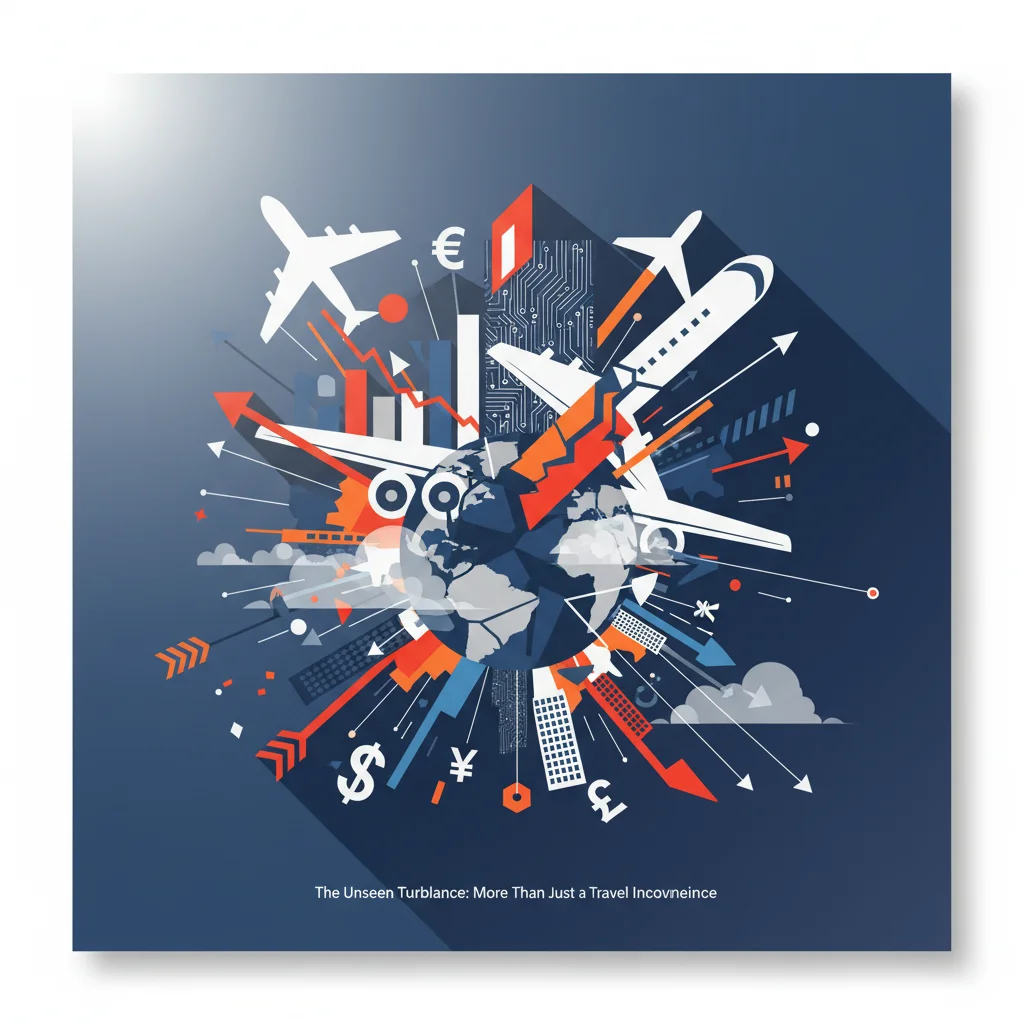
Cleared for Chaos: How a Government Shutdown Grounds Flights and Shakes the Global Economy
The Unseen Turbulence: More Than Just a Travel Inconvenience
This Friday, the familiar hum of air travel across the United States is set to become noticeably quieter. In a move sending ripples through the travel industry and beyond, Transportation Secretary Sean Duffy announced a stark measure to preserve air safety amidst a looming government shutdown: a 10% reduction in flights at 40 of the nation’s key airports. While the immediate impact will be felt by travelers facing cancellations and delays, the true story extends far beyond the airport terminal. This is not merely a logistical headache; it is a potent economic indicator, a canary in the coal mine signaling significant turbulence for the U.S. economy, the stock market, and global investors.
For business leaders, finance professionals, and astute investors, these flight cuts are a critical data point. They represent the first tangible consequence of political gridlock, a physical manifestation of a disruption that will inevitably cascade through supply chains, corporate earnings, and market sentiment. Understanding the “why” behind these cancellations and tracing their economic fallout is essential for navigating the volatile period ahead. This analysis will deconstruct the immediate impact on aviation and expand to the broader implications for investing, banking, and the macroeconomic landscape.
Why Are Flights Being Cut? A Look Behind the Curtain
The official reason cited by the Transportation Secretary is the imperative to “keep air travel safe.” But what does a government shutdown have to do with airline safety? The answer lies with the thousands of federal employees who form the backbone of the nation’s aviation infrastructure, most notably, the air traffic controllers (ATCs).
ATCs are employees of the Federal Aviation Administration (FAA). During a shutdown, they are deemed “essential personnel” and are legally required to work, but crucially, they do so without pay. This creates an environment of immense financial strain and psychological stress. As a report from the Congressional Research Service highlighted during a previous shutdown, this can lead to “higher-than-normal absenteeism and an increase in retirements,” straining the air traffic control system to its breaking point. A reduced number of available, focused controllers means the system can no longer safely handle its full capacity. The decision to cut flights is, therefore, a preemptive safety measure to align air traffic volume with diminished operational capacity. It’s a direct consequence of a breakdown in government funding, forcing a vital national service into a state of managed decline.
A Tale of Two Titans: Why Wall Street Cheered Google's AI Strategy and Jeered Meta's
The Economic Ripple Effect: From Tarmac to Wall Street
A 10% reduction in flights is not a contained event. It is the first domino in a chain reaction that will touch nearly every corner of the U.S. economy. The direct financial losses to airlines from canceled bookings are just the beginning. The broader consequences are far more significant and complex.
Think of the interconnected web of industries reliant on air travel. The hospitality sector—hotels, restaurants, and conference centers—will face immediate cancellations. The tourism industry will suffer as both domestic and international visitors postpone trips. The Congressional Budget Office (CBO) estimated that the 35-day shutdown in 2018-2019 reduced the level of real GDP by an estimated $11 billion, a stark reminder of the real-world costs of political impasse. A significant portion of that loss can be attributed to disruptions in federal operations and the subsequent chilling effect on commerce and travel.
Below is a breakdown of the sectors most vulnerable to these travel disruptions and the potential financial consequences for each.
| Industry Sector | Nature of Impact | Potential Financial Consequences |
|---|---|---|
| Aviation & Aerospace | Direct flight cancellations, reduced passenger and cargo revenue, delayed aircraft maintenance and certification by the FAA. | Immediate revenue loss for airlines, decreased stock valuations, potential credit rating downgrades, and supply chain issues for manufacturers. |
| Hospitality & Tourism | Cancelled business conferences and leisure travel, leading to lower hotel occupancy rates and reduced spending at tourist destinations. | Sharp decline in quarterly earnings for hotel chains, restaurants, and entertainment venues. Layoffs of service-sector employees. |
| Retail & E-commerce | Disruption to air cargo, delaying delivery of high-value goods and just-in-time inventory. Reduced foot traffic in airport retail. | Supply chain bottlenecks, increased shipping costs, and potential loss of sales for time-sensitive products. |
| Finance & Banking | Increased market volatility, decreased consumer confidence impacting loan demand, and potential defaults from heavily affected small businesses. | Pressure on lending portfolios, reduced investment banking activity due to market uncertainty, and a need to reassess risk models. |
An Investor’s Playbook for Navigating Shutdown-Induced Volatility
For the investment community, a government shutdown is a signal to heighten vigilance. The stock market abhors uncertainty, and these flight reductions are a tangible symbol of the economic uncertainty to come. Airline stocks (like American, Delta, and United) and adjacent travel stocks (such as Booking Holdings, Expedia, and major hotel REITs) will be the first to feel the pressure.
However, seasoned investors know that panic is not a strategy. The key is to differentiate between short-term noise and long-term fundamentals. While a short-term trader might see an opportunity in shorting airline stocks, a long-term investor should assess whether the fundamental business case for these companies is permanently impaired. Historically, the market impact of shutdowns is often temporary. An analysis by LPL Financial found that during 21 government shutdowns since 1976, the S&P 500’s performance was “more of a nonevent in the long run,” with a median return of 0.0% during the shutdown periods (source). The real risk lies in a prolonged shutdown that begins to materially affect GDP and corporate earnings for an entire quarter.
Investors should focus on:
- Assessing Portfolio Exposure: Review your holdings for over-exposure to directly affected sectors like travel, hospitality, and government contractors.
- Focusing on Quality: In times of uncertainty, capital tends to flow towards companies with strong balance sheets, consistent cash flow, and low debt—the so-called “quality” stocks.
- Avoiding Knee-Jerk Reactions: Emotional trading based on headlines is rarely profitable. Stick to your long-term investing thesis unless the fundamental economic outlook changes dramatically.
The Scarcity Premium: Why Human Insight is the New Gold in an AI-Driven Economy
The Path Forward: From Ground Stop to Economic Takeoff
Once the political impasse is resolved and government funding is restored, the process of recovery begins. However, the system doesn’t simply snap back to normal. The FAA will need time to clear backlogs of certifications and administrative tasks. Airlines will have to manage the complex logistics of reinstating thousands of flights, a process that can take days or even weeks to fully stabilize. The economic damage, particularly the lost wages and business revenue, is often permanent.
From a macroeconomic perspective, economists and investors will be closely watching key indicators to gauge the depth of the damage and the pace of recovery. These include:
- Consumer Confidence Index: A key measure of household sentiment, which directly impacts spending.
- Weekly Jobless Claims: To see if the disruption has led to layoffs in affected industries.
- GDP Growth Figures: The ultimate measure of the shutdown’s economic cost for the quarter.
- Airline Passenger Throughput Data: A real-time indicator of the travel industry’s return to normalcy.
The role of financial technology will also be critical in the recovery. Fintech platforms offering small business loans and flexible cash flow management tools can provide a lifeline to companies struggling with the shutdown’s aftermath. Likewise, advanced analytical tools can help investors and corporate finance teams model the impact of the disruption and adjust their strategies accordingly.
The Incredible Shrinking Shopping Cart: How "Shrinkflation" is Silently Eroding Your Wealth
Conclusion: A Wake-Up Call for the Economy
The impending 10% cut in U.S. flights is far more than a travel statistic. It is a stark and visible warning of the profound economic consequences of governmental paralysis. It demonstrates how quickly political dysfunction can translate into tangible economic pain, disrupting industries, rattling the stock market, and undermining investor confidence. For anyone involved in finance, investing, or business leadership, this event should serve as a critical reminder: the stability of our economic systems is intrinsically linked to the stability of our governing institutions. Watching the departure boards at the nation’s airports will, for the next few weeks, be an exercise in tracking not just flights, but the very health of the U.S. economy.


